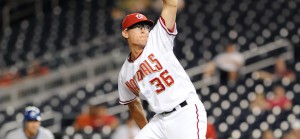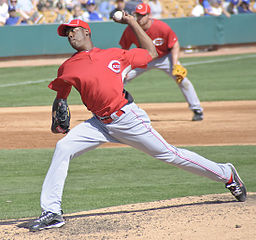This time of year is generally light on pure Nats coverage for me: I like to track local Prep tournaments, I like to track the CWS tourney, and I like to do draft prep. All of these these things basically hit at the same time between Mid-May and Mid-June. So bear with me if these aren’t your cup of tea. I’ll get back to my “where are they now” series soon, as well as more regular stuff on the Nats.
I didn’t even bother to post about the ridiculous Bryce Harper/Hunter Strickland brawl. I’ll say this: I got a MLB.com app notification on my phone that said simply, “Harper charges the mound in SF” and I immediately said to myself, “Strickland must have hit him.” So clearly the intent was obvious, and I think personally the right punishment was arrived at (Bryce 3 games for charging the mound, Strickland 6 days for his ridiculous action).
But, I know my readers mostly care about the Nats. So luckily MLB.com Nats beat reporter Jamal Collier posted an Inbox last night, so I have some Nats content to invent. Here’s how i’d have answered the questions he took.
Q: Have any reason why Bryce has struggled the past few games? Seems like his batting average and other numbers has taken quite a hit.
A: I’d probably say “regression to the mean.” Nobody can post a 1.200 OPS for an extended period of time (Harper had a 1.281 OPS in April). But he’s also been a bit unlucky in May in terms of BABIP (.268), just as he was overly lucky in April (BABIP of .429). I’m guessing he’ll eventually settle back into a .310-.320 BABIP (he does hit the ball hard, so it shouldn’t be a surprise to see his BABIP regularly higher than league average; his career BABIP is .320) and his numbers will rise back up to impressive levels.
I also notice that he hasn’t missed a game yet; he has sat just one game and got a PH appearance in it (April 24th). Dusty Baker gives other guys regular rest but Harper hasn’t sat in 6 weeks … maybe he was just starting to drag a bit. The suspension will be well-timed, especially since it takes him out of the Oakland series (death to hitters).
Collier attributes it to regression as well.
Q: If Glover keeps up his recent dominance, will he stay closer rest of season or do Nats trade for Robertson or Herrera?
A: Well, the question here really should be, “Has the Ownership learned its lesson about fiddling with the closer yet?” I’m not entirely sure they have; they still seem to buy into the closer narrative, a mind-set that led to them jerking around Drew Storen constantly and demoting him during perhaps his best season. So will the narrative continue in 2017? It goes like this: “Gee yeah Koda Glover has been throwing the ball really well, but he’s a rookie so he can’t possibly handle the pressure of October baseball, so we better get the “Proven Closer” and pay out the wazoo for him because that’s what we really need in the playoffs.”
I hate that mindset. Yes Storen blew a couple of games in the post season; he pitched a grand total of 5 1/3 post-season innings for the Nats across 6 games, and in four of those games he gave up zero runs. Can you say “small sample size?” But to continue to over-react and over-pay for closers is something this team has to stop doing. Lest I remind everyone of Joe Posnanski‘s research on the topic: teams have won 95% of games they lead in the 9th for about the last 100 years, irrespective of whether they were throwing Joe Schmoe in the 9th in the 40s or Goose Gossage in the 70s or Aroldis Chapman today.
Right now Glover, at league minimum salary, is posting a 200+ ERA+ figure and hasn’t given up a run in a month. Meanwhile, two of the the three big-money closers on the FA market this past off-season have hit the D/L and have worse seasonal numbers for approximately 30-times the salary. Which situation would you rather be as a team and a GM?
So; if Glover keeps pitching well (and as long as he’s throwing a 95mph cutter or slider or whatever it is, he should), then leave him there and augment the bullpen at the trade deadline with quality middle relievers who won’t cost as much in terms of prospects. That’s my suggestion.
Collier thinks the Nats may still get a closer at the trade deadline, and noted (using Storen as an example) that they’ve not hesitated to replace a closer mid-season in the past. In other words .. he thinks they may go ahead and do something stupid too.
Q: Question for your mailbag: can we expect Albers to revert to his norm? Same for Taylor? (That K rate and BABIP…)
A: Yeah, at some point. There was a reason Matt Albers was a NRI this past off-season, and there’s a reason Taylor has now had nearly 1,000 major league PAs and is still slashing just .234/.285/.374 for his career. As far as Albers goes … its ok to have a 6th/7th inning guy who gets blown up every once in a while, as long as those outings are mitigated and don’t really cost you games all that much. So far, he’s been so much better than expected for us. Projecting forward, his FIP is a bit higher than his ERA and his BABIP is unsustainably low (.208), so we’ll see some regression back to the mean. But also there’s this: for as bad as he was in 2016, he was great in 2015. Who is to say that 2016 was the one-off season and he’s re-gained whatever enabled him to post a 1.21 ERA in 30 appearances for the White Sox?
As for Taylor, I’m not going to re-litigate the whole “Can Michael Taylor turn it around” case. There’s clearly people dug into the sand on both sides. His BABIP with his current surge of productivity is .385; that’s all that we need to say. At some point he’s going to stop having stuff fall in for hits and he’ll regress back to the .230 hitter he’s always been. Lets just hope Baker is smart enough to keep him in the 8-hole as it happens. That or recognize it as it happens and think about giving those empty ABs to someone else when it happens.
Collier thinks both players are coming back to earth at some point.
Q: In the time you’ve been covering the Nats, tell us about the value you see JW adding to the team and clubhouse
A: Hard for an armchair psychologist such as myself to give an intelligent answer here. I know there are many who read this who put little to no value in “clubhouse chemistry,” “team leadership,” and other fuzzy emotional issues when it comes to professional athletes, and I’m fine with that. I tend to think that clubhouses work like any other workplace team; you have “good” co-workers and “lazy” co-workers, you have respected leaders who have “seen it all” and who have “been around the block” and you have rookies who do dumb things because they just havn’t been around that long. So in that respect, Jayson Werth should be a valued team-mate who steps up and helps lead the clubhouse, but I have no idea if he actually does. Its all conjecture on my part, having never stepped into a MLB clubhouse.
Collier says … similar things to what I just said. Its hard to value leadership. But he also says (and I agree) that Werth has proven he deserves another contract. I wonder if it will be with us.


